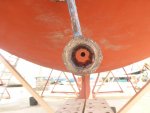slawosz
Active member
Hi,
The dreaded set screws turned out to be no issue for my P-bracket, but, after comparing it with other brackets in the club, I noticed mine is weirdly built. It appears to have an internal rim that is blocking access to the cutlass bearing from the shaft side. It appears I cant remove the bearing without removing the shaft, and even then I probably need to use a hacksaw to remove the old bracket.
Have you seen something like this before? Photos and drawings below, full CAD drawing: Fusion
Prop side: I think there is little of the bearing tube here:

Shaft side - tube hidden.

Entire p-bracket crossection:

Crossection without bearing:

free image hosting
The dreaded set screws turned out to be no issue for my P-bracket, but, after comparing it with other brackets in the club, I noticed mine is weirdly built. It appears to have an internal rim that is blocking access to the cutlass bearing from the shaft side. It appears I cant remove the bearing without removing the shaft, and even then I probably need to use a hacksaw to remove the old bracket.
Have you seen something like this before? Photos and drawings below, full CAD drawing: Fusion
Prop side: I think there is little of the bearing tube here:

Shaft side - tube hidden.

Entire p-bracket crossection:

Crossection without bearing:

free image hosting

